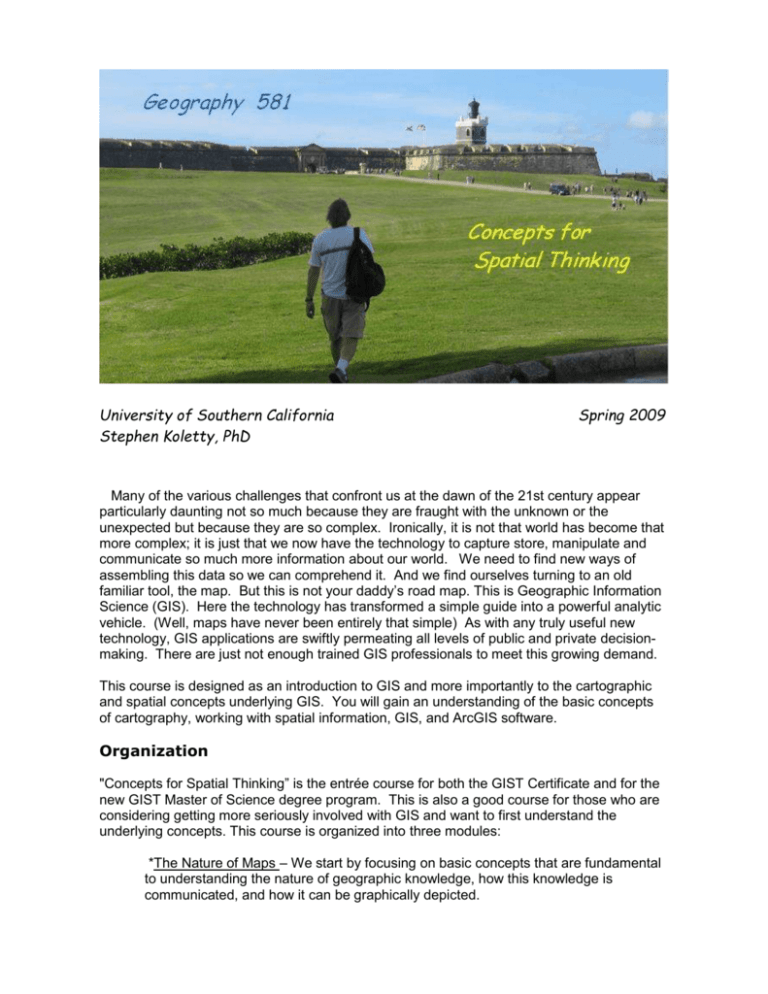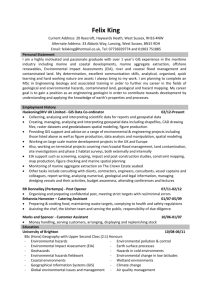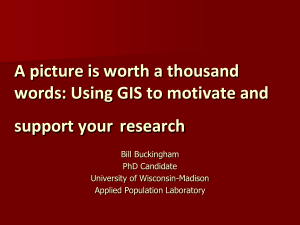Geography 581: Concepts for Spatial Thinking
advertisement

University of Southern California Stephen Koletty, PhD Spring 2009 Many of the various challenges that confront us at the dawn of the 21st century appear particularly daunting not so much because they are fraught with the unknown or the unexpected but because they are so complex. Ironically, it is not that world has become that more complex; it is just that we now have the technology to capture store, manipulate and communicate so much more information about our world. We need to find new ways of assembling this data so we can comprehend it. And we find ourselves turning to an old familiar tool, the map. But this is not your daddy’s road map. This is Geographic Information Science (GIS). Here the technology has transformed a simple guide into a powerful analytic vehicle. (Well, maps have never been entirely that simple) As with any truly useful new technology, GIS applications are swiftly permeating all levels of public and private decisionmaking. There are just not enough trained GIS professionals to meet this growing demand. This course is designed as an introduction to GIS and more importantly to the cartographic and spatial concepts underlying GIS. You will gain an understanding of the basic concepts of cartography, working with spatial information, GIS, and ArcGIS software. Organization "Concepts for Spatial Thinking” is the entrée course for both the GIST Certificate and for the new GIST Master of Science degree program. This is also a good course for those who are considering getting more seriously involved with GIS and want to first understand the underlying concepts. This course is organized into three modules: *The Nature of Maps – We start by focusing on basic concepts that are fundamental to understanding the nature of geographic knowledge, how this knowledge is communicated, and how it can be graphically depicted. Concepts for Spatial Thinking 2 *Spatial Thinking – In this section we examine some basic notions of cognition, mental representations of space, meaning in maps, spatial thinking and spatial problems. *Fundamentals of GIS – This section actually entails most of the course. Here we examine the nature of computer systems and that of geographically referenced data. We will be providing you a structured introduction to ArcGIS 9.2, the most recent version of the most widely used GIS software. At the same time we shall consider various aspects of spatial analysis, data input and verification, data analysis and modeling. We will also review the history and development of GIS, the costs and disadvantages of GIS and likely future developments in GIS. Teaching and Learning Strategies This particular course presents some unique challenges for me as an educator and for you as students. These challenges arise from the technical nature of GIS, the fact that this course is a graduate course, and that Geography 581 is a distance learning course. Basically, GIS is just software and data, just computer code. We will be providing you with our own instructional tutorial on ArcGIS. However, the power, indeed magic, of GIS is what you do with it. So this course is not just about learning GIS software. It is about teaching you to understand certain spatial and cartographic concepts so you can master that potential power. Yet, because of the technical character of GIS, there exists a tendency to focus on the software and data. This a graduate level course, so you should expect this class to be both academically robust and intellectually challenging. A good graduate learning setting occurs within the heady cauldron of ideas, opinion, and analysis that describe our collective effort to thoroughly interrogate the subject at hand. Learning arises from active engagement with the knowledge found in our reading materials and with one another. My role as instructor should be that of a guide that keeps you on this path of discovery. The challenge for us is how we can replicate such an academic experience within the milieu of “distance learning”. Perhaps, some of you may already have had experience with an online course. Inevitably, such courses seem to involve programmed readings and exercises, but not much interaction directly with the instructor and certainly none with fellow students. In the realm of computerized learning it is not really surprising that the default is to the solitary gamer. To counter this tendency I am deliberately incorporating specific methodologies to encourage and facilitate our interaction. These include: Individual meetings: Over the next few weeks, I want to meet with each of you individually. I expect this meeting should not take more than about 20 minutes. For those on campus or nearby, contact me at koletty@usc.edu to schedule a convenient time. My office presently is in Kaprielian Hall, Room KAP 448C. Tuesday, Wednesday and Thursday afternoons work best for me, but I can arrange a meeting at another time or after hours. For those off campus or at some distance, we will have our meeting online. For this you will need to acquire a video cam and headset. If you do not already have one, then we recommend Microsoft LifeCam VX-3000. After you get the unit working access Skype at http://www.skype.com/download/ and download the program (it’s free). Once you've installed it search for me: Contacts > Search for Skype Users... enter my email address: koletty@usc.edu, my username is s.koletty, Los Angeles. Only one entry should come up. Add me as one of your contacts, then e-mail me to schedule a time for our online videocam meeting. Concepts for Spatial Thinking 3 Video conferencing: I plan to schedule three class meetings over the semester. Attendance at least two of these meeting will be mandatory. In order for those off campus and at distant locations to be able to fully participate, we will set these up as videoconferences. I will be polling you as to what the best timing should be, but be aware that we might be constrained by the availability of facilities. Team assignments: There will be at least one project in which you will be paired with another classmate. Shared work: There will be some coursework that you will be doing also for the benefit your classmates. Specifically, each of you will be assigned one or more of the readings to summarize and distribute to the rest of the class. Critiques: For certain assignments you will be tasked to analyze and critically review one another’s work. Introductions: To get a start on getting to know one another, I want you to prepare a biographical sketch of about 100 words. By the end of the first week, you should post your bio and a recent photo on Blackboard. Select the “Homepage” option under the “581 Tool Kit” button. You will be able to view each other’s Homepage at the “Roster and Email” button, but only you have access to make changes in “My Homepage”. Grading Your grade in this class will be determined on the basis of several mapping exercises, a brief paper, a semester project in GIS, completion of the two ESRI Virtual Learning modules, your participation in various assignments and your contributions to the class. Grades will be weighted according to the following schedule: Maps and Critiques Semester GIS Project – Proposal & draft Semester GIS Project -- Final GIST Instructional Tutorials Other Assignments/participation (20%) (10%) (20%) (28%) (22%)







